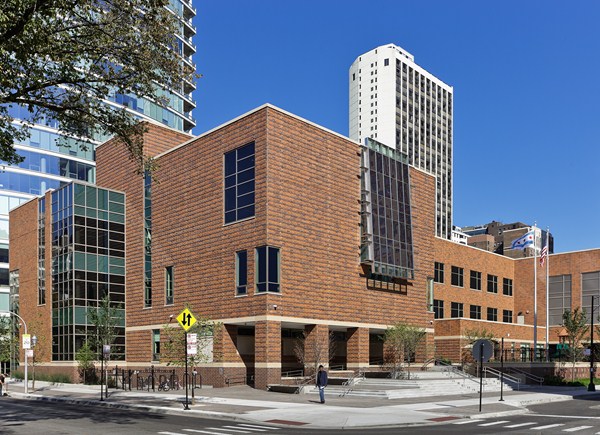The Brick Industry Association (BIA) has opened entry submissions for its 2013 Brick In Architecture Awards—with a new Renovation/Restoration category and new category divisions this year. BIA’s annual awards honor architectural excellence and sustainable design nationwide that incorporates clay brick products as the predominant exterior building or paving material. Entries are due by April 30. To enter and for details, go to: http://www.gobrick.com/EventsEducation/BrickInArchitectureAwards/tabid/7661/Default.aspx
The 2013 awards competition will be conducted entirely online. Architectural and design firms from around the country can enter their best material to be judged by a jury of their peers.
“As a versatile building material made in America made from abundant natural resources, there is no substitute for genuine clay brick,” said BIA President and CEO Gregg Borchelt, P.E. “In addition to its unmatched durability and many benefits from its physical properties, brick offers aesthetic flexibility to match the architect’s imagination and desires, and is a main element in sustainable design,” he said.
As the largest and most prestigious juried competition of its kind, entries can be submitted in one or more of the below categories:
- Commercial (Under $10 Million) – New
- Commercial (Over $10 Million) – New
- Education – K-12
- Education – Colleges & Universities (Higher Education)* – New
- Health Care Facilities
- Municipal / Government
- Houses of Worship
- Residential – Single Family
- Residential – Multi-Family
- Renovation (Additions)** / Restoration (Restoring) – New
- Paving & Landscape Projects
*Includes residence halls & academic/administrative buildings
**Additions must use at least 50 percent new clay brick products on the building. Restoration construction must include at least 50% clay brick products, which can either be new or salvaged.
For complete information on eligibility, submission requirements, and judging, visit
http://www.gobrick.com/EventsEducation/BrickInArchitectureAwards/tabid/7661/Default.aspx
Founded in 1934, the Brick Industry Association (BIA) is the nationally recognized authority on clay brick construction representing the nation’s distributors and manufacturers of clay brick and suppliers of related products. Web site: www.gobrick.com /703-620-0010.
Related Stories
| Dec 29, 2014
Wearable job site management system allows contractors to handle deficiencies with subtle hand and finger gestures [BD+C's 2014 Great Solutions Report]
Technology combines a smartglass visual device with a motion-sensing armband to simplify field management work. The innovation was named a 2014 Great Solution by the editors of Building Design+Construction.
| Dec 29, 2014
From Ag waste to organic brick: Corn stalks reused to make construction materials [BD+C's 2014 Great Solutions Report]
Ecovative Design applies its cradle-to-cradle process to produce 10,000 organic bricks used to build a three-tower structure in Long Island City, N.Y. The demonstration project was named a 2014 Great Solution by the editors of Building Design+Construction.
| Dec 29, 2014
14 great solutions for the commercial construction market
Ideas are cheap. Solutions are what count. The latest installment in BD+C's Great Solutions series presents 14 ways AEC professionals, entrepreneurs, and other clever folk have overcome what seemed to be insoluble problems—from how to make bricks out of agricultural waste, to a new way to keep hospitals running clean during construction.
| Dec 29, 2014
HealthSpot station merges personalized healthcare with videoconferencing [BD+C's 2014 Great Solutions Report]
The HealthSpot station is an 8x5-foot, ADA-compliant mobile kiosk that lets patients access a network of board-certified physicians through interactive videoconferencing and medical devices. It was named a 2014 Great Solution by the editors of Building Design+Construction.
| Dec 28, 2014
Robots, drones, and printed buildings: The promise of automated construction
Building Teams across the globe are employing advanced robotics to simplify what is inherently a complex, messy process—construction.
BIM and Information Technology | Dec 28, 2014
The Big Data revolution: How data-driven design is transforming project planning
There are literally hundreds of applications for deep analytics in planning and design projects, not to mention the many benefits for construction teams, building owners, and facility managers. We profile some early successful applications.
| Dec 28, 2014
AIA course: Enhancing interior comfort while improving overall building efficacy
Providing more comfortable conditions to building occupants has become a top priority in today’s interior designs. This course is worth 1.0 AIA LU/HSW.
| Dec 28, 2014
6 trends steering today's college residence halls
University students want more in a residence hall than just a place to sleep. They want a space that reflects their style of living and learning.
| Dec 28, 2014
Using energy modeling to increase project value [AIA course]
This course, worth 1.0 AIA LU/HSW, explores how to increase project value through energy modeling, as well as how to conduct quick payback and net present value studies to identify which energy strategies are most viable for the project.
| Dec 28, 2014
The lowdown on LODs: Bringing clarity to BIM
These days, BIM is par for the course across most facets of design. But a lot of the conversation surrounding BIM still lacks clarity due to ambiguous terminology, a lack of clear-cut guiding illustrations, and widely varying implementation, writes GS&P's John Scannell.

















